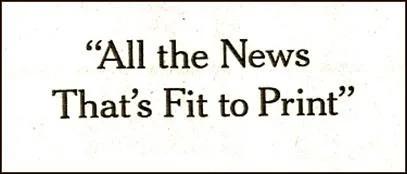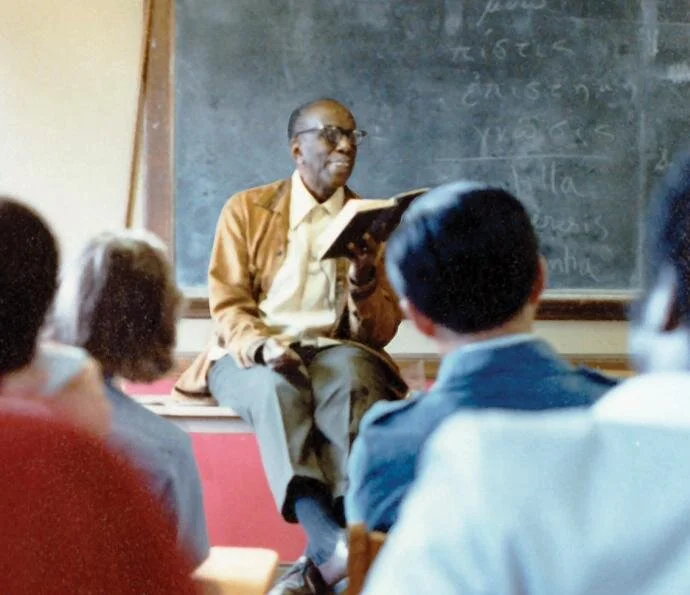How does St. Stephen speak for us? Part II
Father Peter and Suzanne will retreat from St. Stephen’s until September. In their absence, we’ll revisit some of their recent Reflections as springboards, or perhaps compasses, for much-needed broader reflections on any course forward. We begin with Suzanne’s foundational questions about this church, how it came to be associated with St. Stephen and how that first martyr/deacon speaks for us today.
Today we explore who we at St. Stephen’s have been at two turbulent moments, including the present. Our undertaking perfectly suits our mission in Advent: To reflect on who we are, how we change, who we’re becoming. The path we’ll survey here suggests how radically different each of such moments is, yet how certain crises repeat and repeat. . . . Uncannily, this Early Christian martyr steps in to speak for us every time.
Again, I’ll use the saint’s first name only to more easily distinguish him from his namesake churches. And “church” in lower case identifies specific congregations as opposed to “Church,” the comprehensive body of Christians.
One of the challenges of searching for Stephen’s role within churches like ours is finding overt signs of his invocation in church activities or words. I have yet to find any significant mention of him in church documents after its founding. That absence sent me to any physical manifestations—consciously chosen, displayed images—within the building and how he is represented or interpreted there, when, and by whom. Yes, my art historian’s convictions kick in. But, I contend, much can be learned from these images about those who placed them within the space that publicly represents the community and participates in their activities.
Tiffany Chancel of 1917 seen in 1939
The story begins as our church prepared for its first centennial in 1923 and concludes today, as we approach our second 100 years. In the process, Stephen becomes visually prominent as never before.
Stephen moves to center stage in 1917
In 1917, the church commissioned a complete redecoration of the church from Louis C. Tiffany, a quietly luminous world that emphasized a new chancel.
Why such a radical change? A ready answer is that, to herald its entry into its second century, the congregation jettisoned the old (the 1878 Furness “Victorian” design that had just been restored) to move forward in a glamorous new suit. The 1917 decoration, as you see, is still with us today.
Yet details matter. There, presiding over the altar, within delicate marble grillwork, are three vertical lights with stained-glass medallions that represent the life and words of the church’s patron saint.
Stephen is now at center stage in multiple images that tell a story: There are 11 episodes in 13 elements. Again, why?
This historic church may be saluting its own beginnings by celebrating Stephen’s pivotal role in the birth of the Church. For details, go to Part I of this Reflection on Stephen (December 4]). I suggest that the choice also subtly proclaims what this congregation stands for in 1917, which differed considerably from priorities at its founding. St. Stephen’s rector, Dr. Carl E. Grammer, a scholar of church history, likely selected the subjects and had a purpose for his approach to the story.
Detail: Tiffany Stephen windows, 2017
Because we lack good photographs of the individual medallions, which are unevenly lit due to unstable backlighting, I’ll simply challenge your imagination with this blurred detail and summarize their story as described by Dr. Grammer after they were installed.
The subjects, he notes, derive from the account of Stephen in Acts (Acts 6-7); again, you’ll find details and context in Part I of this Reflection. The windows roughly build a story downward from the top of the far left light (north) to the top of far right light (south) and concludes in the larger center light shaped like a cross to associate the first martyr Stephen with Christ and the Early Church.
The 13 medallions open with Stephen’s ordination and proceed with his “building up Christianity with his preaching (according to Dr. Grammer).” Stephen’s teaching draws the attention of the highest Jewish Council, the Sanhedrin, that is (falsely) told that Stephen is overthrowing Moses’ law. He is also accused of warning of the destruction of Solomon’s Temple, that handmade temple where, Stephen reminds them, God does not dwell, as the prophet asserted. The medallions further celebrate the “brotherly love of the [Church]” and the “great company of the priests” who left their own communities to follow Stephen and other Christian preachers. The center light represents Stephen’s vision of the risen Christ affirming his witness as he argued before the Sanhedrin; his death by stoning (3 medallions to emphasize a mob), and the converted Paul as Stephen’s energetic successor.
What’s missing? Stephen the deacon, the energetic servant of the needy.
Through what is shown (Stephen the Evangelist), the Tiffany windows dwell on the beleaguered spread of the Word and the doctrinal history of the Church, especially its purity in adhering to Christianity’s ancient foundations, unlike other Jewish factions. The windows also celebrate an evolving Church comprised of diverse entities working in harmony.
This narrative perfectly fits Dr. Grammer and the congregation that called and followed him for thirty years. Unlike St. Stephen’s High-Church and conservative rectors until 1880, Dr. Grammer was a committed, if nuanced, Evangelical; the Word was paramount and the Church purest when it follows the primitive Church as rendered in the New Testament.
Yet there’s an intriguing discrepancy. The Tiffany Stephen windows highlight the problematic Solomon’s Temple built by human hands and Stephen’s insistence on God’s assurance that he is everywhere but in such a human construct. Where does that place the human-made St. Stephen’s and the artful new program about its house-averse patron saint?
Dr. Grammer was not as dogmatic as Stephen or radical Evangelists.
Dr. Grammer’s affinities with Stephen about God’s presence, however, appear soon after the chancel was completed: the disastrous Spanish influenza pandemic of 1918 in which thousands sickened and died just in Philadelphia. The crisis brought local clergy into bitter conflict over the municipal order to limit church activities but not others. Dr. Grammer was a forceful leader of an interdenominational group that publicly supported the order. St. Stephen’s shut down completely.
Dr. Grammer was virtually channeling Stephen when he explained these actions to the congregation: “God has revealed Himself to us as an omnipresent spirit. . . . “ Unlike Stephen, Dr. Grammer claimed God could accept temporary retreat from the church for a crisis like the pandemic that threatened the welfare of others. Dr. Grammer accepted churches as God’s house in their multiplicity; this was not Solomon’s Temple. Could Stephen be so flexible in changed times?
How does Stephen speak for us today?
It’s uncanny that the same crisis of pandemic overwhelmed us almost a century later, 2020, and that we today, like Dr. Grammer in 1918, might channel Stephen in our support for worshipping anywhere and shutting down the church. In our more litigious times, a law suit against government restrictions to religious freedom goes to the Supreme Court.
We, however, can continue virtually, online.
The shutdown and today’s alternatives intensify the questions about how necessary is the physical church in this age of alternatives, physical and electronic? If not necessary, how do we use our sanctuaries if we keep them? All questions relating to Church, ministry, religion, and even spirituality escalate as we ponder who we are and how to make a better world.
This moment marks our own version of the Reformation, pruning away accumulations to essentials. Or maybe we’re reliving the birth of the primitive Church, starting anew.
Stephen emerges powerfully as our advocate and voice today. He’d probably delight in our virtual or multiple-venue activity. Divine presence, after all, is everywhere. We might eventually take our mission everywhere, with the historic physical church as a time-honored base and sanctuary.
Our actions can complement the 1917 Tiffany windows about Stephen the Evangelist. Stephen officially and beautifully epitomizes Christianity’s mandate of service to the needy, a mission that becomes ever more urgent with pandemic and its aftermath. It’s a role the Church has highlighted over time, as we saw last week in Fra Angelico’s frescoes that defined Pope Nicolas V’s vision of his mission. I include the relevant scene here for emphasis, where Stephen’s service as deacon appears to the right.
Fra Angelico, Consecration of St. Stephen and St. Stephen Serving the Needy, 1447/9, Niccoline Chapel, Vatican
Stephen, the model Christian deacon, is unique and symbolically crucial. The primitive Church, as described in the New Testament, presents his mission of service as simultaneously practical and spiritual; in the Greek bible, ministry and service are indistinguishable and comprehensive. The deacon [diakonos] performs service to God that is expressed by ministry to people, God’s creation. The twelve apostles, who opted to specialize in preaching and praying as their followers multiplied, nonetheless demanded the highest spiritual and practical credentials of those chosen: The seven men should be “of honest report, full of the Holy Ghost and wisdom, whom we may appoint over this business [Acts 6:3].” Some contemporary thinkers take this instruction to propose that “ministry is any service rendered by a Christian that is motivated and empowered by the Holy Spirit that benefits mankind, saved and unsaved, and brings glory to God (bible.org).”
The service invoked in Acts (at least in English translations) requires a work area (described as a table) in an accessible space for the needy. Fra Angelico’s fresco, as we see, shows service performed at the church. Note the variety of contributions and to whom: coins and food (the departing woman at right) to both residents and visitors (the pilgrim).
As the exemplary Christian minister to the needy with food, Stephen now personifies many modern such services. Food pantries throughout the United States today, often but not always church-sponsored, are named for him. Some are prominent and much-publicized activities of a namesake church: The Episcopal St. Stephen’s Church in Richmond, VA began one to serve those isolated in pandemic. The press highlighted a much older one at St. Stephen United Methodist Church, a tiny church in Ridgeland, SC, that serves the elderly, low-income, and immigrant families, and that recently expanded its services, thanks to a grant.
There are now alternative church-sponsored food operations, like the Black Church Food Security Network in Baltimore,MD (thanks, Fr. Peter!), that operate on mutual aid, partnerships with sustainable farms, and teaching. This is sharing, self-help, rather than the traditional hand-out that marked Christian charity, a contentious point in the civil rights movement since the early 20th century that put the liberal white Dr. Grammer (who upheld Christian charity) at odds with a younger black activist, Richard Robert Wright, Jr., who advocated self-help. We learn, change, and become.
As our own St. Stephen’s moves forward in pandemic, we have the opportunity to serve a highly diverse community with many needs: those with multiple problems experiencing homelessness, some nomadic, some attached to our streets. We reside between two old racially and culturally different communities: Chinatown to the north and a black neighborhood to the south. Our streets and public transport connect us to many more within the city and beyond. The city has roiled with old problems intensified by pandemic: sickness, economic distress, poverty, racism, and the vulnerability of the undocumented even in a Sanctuary City.
Himself a marginalized immigrant in a volatile heterogenous region, Stephen exemplifies the impact of acknowledging and serving diverse communities often at odds.
Our church, so well situated, could fuse the New Testament’s vision of the practical and spiritual through such ministry thanks to Stephen’s example and persuasive voice.
What better time to consider needy neighbors than on the imminent feast day of this committed, effective, and undeniably devout minority deacon, December 26? Since the Middle Ages, the Church has opened the alms box to the needy on that day, a rite that evolved in Britain into the more developed Boxing Day on that date (“boxing” goods for the needy). The tradition also inspired the popular 19th-c. Christmas carol about “Good King Wenceslas” who plowed through deep snow on foot with goods for a distant peasant on Stephen’s feast day. No sanctimonious do-gooder here: This elderly ruler worked hard to serve especially on this day. Another great model in Stephen’s “footsteps.”
I’ll return to these issues, in a lighter holiday spirit, on Stephen’s feast day itself (remember, December 26). Until then, as we move through Advent, we ask how to emulate Stephen with the needy in our own world?
—Suzanne Glover Lindsay, St. Stephen’s historian and curator









